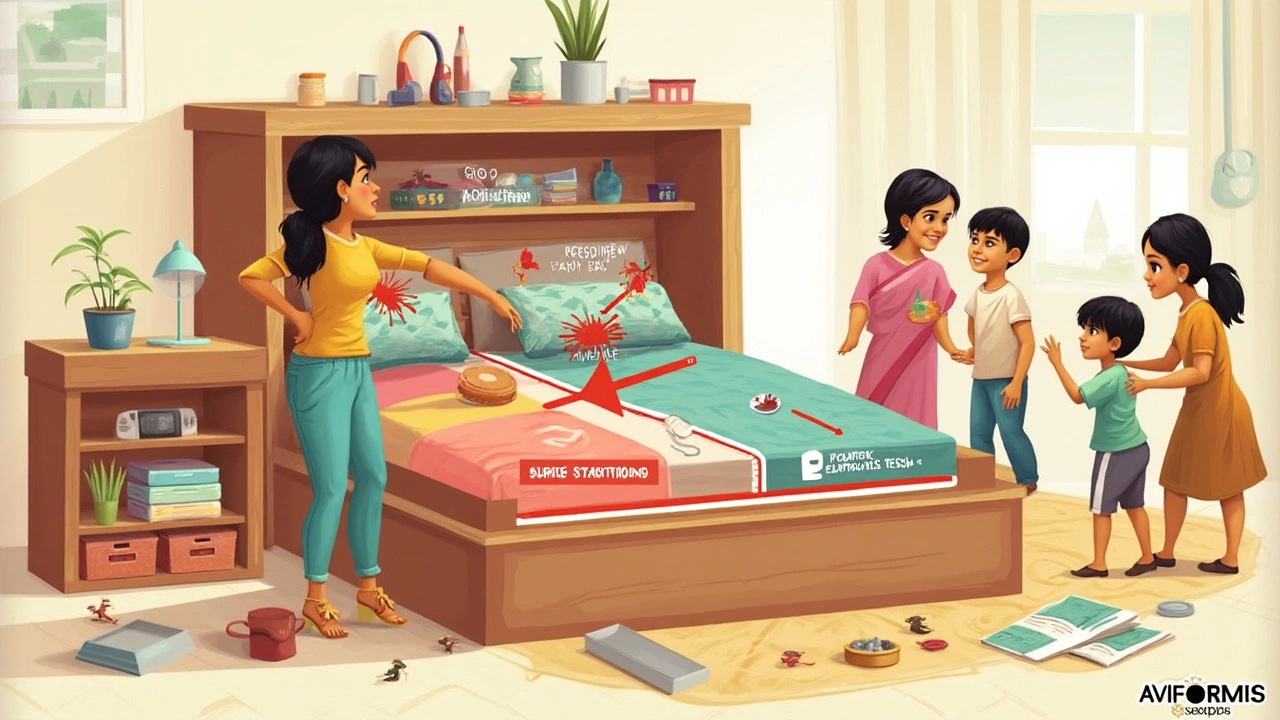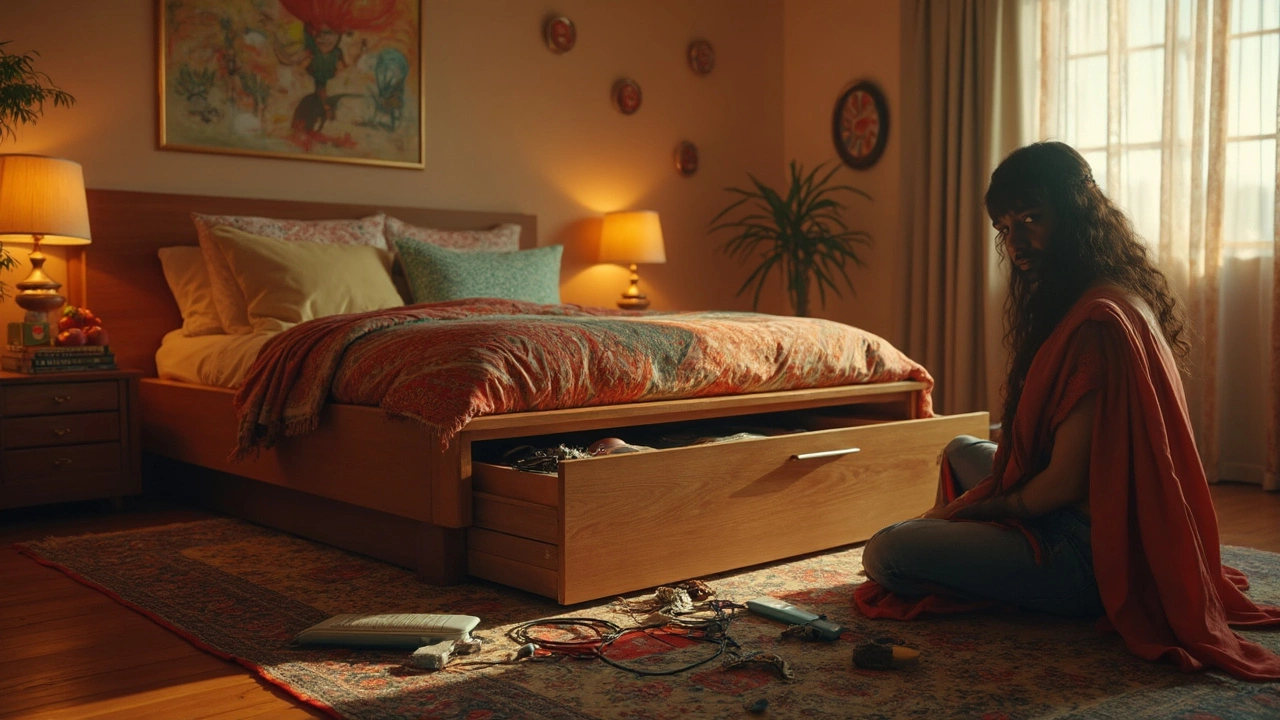Stuffing everything under a storage bed might sound like a clever way to hide extra things, but a little strategy goes a long way. Not everything belongs in those drawers or lift-up spaces, and ignoring a few simple rules can land you in a mess—literally.
Ever pulled out a box only to find your shoes mildewed or that backup phone dead from humidity? It happens. Storage beds can trap heat, moisture, and dust more than you think, so it pays to know what’s safe to stash—and what will come back to bite you.
Think of this as your cheat sheet to making the most of every square inch, without ruining your stuff or attracting problems like bugs or bad smells. You’ll save yourself future headaches and keep your space just as tidy as you imagined when you bought the bed in the first place.
- Why Storage Bed Choices Matter
- Items That Attract Bugs or Mold
- Sharp, Heavy, or Awkward-Shaped Hazards
- Things That Warp, Smell, or Deteriorate
- Forget-Valuables: Out of Sight, Out of Mind
- Safe Alternatives and Smart Storage Tips
Why Storage Bed Choices Matter
It’s tempting to treat a storage bed like an oversized junk drawer. But what you hide under your mattress can affect your health, your sleep, and how long your stuff actually lasts. Studies by the National Sleep Foundation show that clutter in your sleeping space—even hidden clutter—can mess with sleep quality and stress levels. Filling your storage bed without a plan creates problems that spill over into everyday life.
Space under the bed is a unique environment. It’s darker, dustier, and often more humid than you think. Skip these basics, and you can run into broken gadgets, ruined clothes, or even allergy flare-ups. As organizing expert Marie Kondo puts it,
"Just because an item fits in a space doesn’t mean it belongs there."
Here’s what sets storage beds apart from regular closets or dressers:
- No airflow—heat and moisture can build up quickly.
- Access isn’t always easy, so stuff can be forgotten and left to deteriorate.
- Pest risk goes up, especially if you stash food or organic materials.
Check out these facts that matter before you start packing things below your mattress:
| Factor | Storage Bed | Closet |
|---|---|---|
| Air Circulation | Low | Moderate–High |
| Humidity Risk | High | Low–Moderate |
| Pest Attraction | Moderate–High | Low–Moderate |
| Easy of Access | Low | High |
Your storage bed should help you simplify, not sabotage, your space. Storing smart means picking the right things to stash and knowing exactly what should stay far away from this furniture’s hidden spaces. Stick around for what to avoid if you don’t want unwanted surprises down the line.
Items That Attract Bugs or Mold
This is the big one: if you put the wrong stuff under your storage bed, you’re basically inviting pests and mildew to move in. Storage beds are cozy spots—for spiders, silverfish, and even mold spores, if you’re not careful. It’s crazy how fast these nasty guests show up when you give them a little encouragement.
The worst offenders? Food, anything with crumbs, or even scented items. Got extra snacks or a box of granola bars? Leave them anywhere near your storage bed and you’ll get ants, cockroaches, or worse. Candles, scented sachets, and toiletries aren’t safe either; their smells can draw bugs like magnets.
- Storage bed drawers or lift-ups lock in the air, so if you stash away shoes that are even a tiny bit damp, or leftover gym clothes, that trapped moisture creates a perfect home for mold and musty odors. Clothes that haven’t dried fully can do more damage than you’d expect.
- Important papers, photos, and books are also targets. Silverfish and cockroaches eat paper and glue, and mold loves paper’s porous surface, especially when humidity spikes in the summer.
- Real plants, potpourri, or anything organic (even dried flowers) are risky. They break down slowly, attract small bugs, and shed microscopic bits that become dust and food for pests.
| Item Stored | Problem Caused |
|---|---|
| Unwrapped snacks | Ants, roaches, mice |
| Damp clothes or shoes | Mold, mildew |
| Papers and books | Silverfish, mold spots |
| Organic décor (flowers, potpourri) | Bugs, rot |
So what do you actually do? Give anything you put under your bed a quick check for crumbs, moisture, and smell. Store everything in sealed containers when it makes sense. And at least once a year, pull out what’s under there and give the area a wipe-down (or a quick vacuum) to catch anything before it starts a problem. The truth: one overlooked granola bar can turn that storage bed into a pest party without you even knowing.
Sharp, Heavy, or Awkward-Shaped Hazards
It’s tempting to shove just about anything out of sight in a bed with storage, but some things can become more trouble than they’re worth. Sharp objects—like scissors, knives, tools, or even loose sewing needles—have no business in your storage bed. They can cut or poke holes in fabric pouches, bedding, or even the wood or fabric lining inside the storage compartment. Worst of all, reaching under your bed in a hurry and snagging your hand isn’t anyone’s idea of a good time.
Heavy stuff is another no-go. Storage beds might feel sturdy, but keeping big dumbbells, hand weights, cast-iron pans, or stacks of textbooks down there can warp the base or break drawers over time. Most storage furniture is built to handle lots of folded clothes or a few pairs of shoes, but not the weight of a small gym.
Awkwardly shaped things like tennis rackets, guitar cases, oddly-shaped exercise gear, or even metal tripods don’t just hog space—they make sliding drawers a pain and can jam the mechanism. You’ll end up wrestling with your furniture, risking broken hardware or scraped hands.
- Avoid stashing anything with sharp edges or points, even if you wrap it up. It’s not worth the risk.
- Keep the weight manageable. If it’s heavy enough that you groan picking it up, it’s probably better stored somewhere else.
- If it’s long, bulky, or pokes out at weird angles, it belongs in a closet, garage, or anywhere that won’t mess with the smooth function of your storage bed.
Think of under-bed storage as best for softer, lighter, and flat items—and if it could poke, smash, or break something nearby, keep it out.

Things That Warp, Smell, or Deteriorate
It’s tempting to make a storage bed your catch-all spot, but certain items just can’t handle the ride. Stash the wrong thing and you’ll end up with warped records, smelly linens, or brittle old books you’ll wish you’d left on a shelf instead.
Humidity under the bed is a real thing—even if your room feels dry. Storage beds don’t get as much airflow, so anything that’s sensitive to heat or moisture is at risk. Here’s where trouble crops up most often:
- Vinyl records and old photo albums: They warp and stick together faster under heat and pressure. If you’re a collector, keep these upright in a cooler, dry spot.
- Candles and cosmetics: Heat buildup makes candles lose shape and makeup melt or turn bad. Save yourself a cleanup later.
- Fresh linens or clothing: If they aren’t totally dry, you’ll get mildew, weird smells, and yellow spots. Always air things out before slipping them into storage.
- Books and magazines: Dust and humidity turn pages yellow, musty, and even wavy. Once they take on that odor, it never quite comes out.
- Shoes with leather or suede: Trapped moisture makes them hard and cracked, or even moldy. Shoe boxes are better on open shelves.
If you need a quick reference, this table gives you a snapshot of common problem items and why they struggle in bed storage:
| Item | Risk Factor | What Can Go Wrong |
|---|---|---|
| Vinyl records | Heat, pressure | Warping, sticking |
| Books | Humidity, dust | Mold, yellowing, smell |
| Candles | Heat | Melting, misshapen |
| Linens | Trapped moisture | Mildew, stains |
| Shoes (leather) | Lack of airflow | Cracking, mold |
If in doubt, think of what would survive a car trunk on a hot day. If the answer isn't obvious, better safe than sorry—keep fragile, sensitive, or smelly stuff out from under your storage bed.
Forget-Valuables: Out of Sight, Out of Mind
It’s easy to toss stuff you want hidden into a storage bed—family jewelry, passports, maybe even a few old smartphones. Here’s the catch: storage beds aren’t safes or vaults. Most models have a simple latch or sliding mechanism that’s way too easy for a snooper to access. If you ever need that important document in a hurry, chances are you’ll forget where it’s buried or fumble through piles of linens and boxes.
There’s something else you might not realize: insurance companies often deny claims for valuables stored in unsecured areas like a storage bed. If you’re stashing cash, gold, or sentimental items, it’s almost impossible to prove they were there if they go missing. Plus, these beds get moved and bumped—for example, while vacuuming—which increases the risk of damage or loss.
Another pitfall is temperature swings. Storage beds are near the floor, where it tends to be a few degrees cooler or more humid, especially in older houses. Paper documents, electronics, and other sensitive valuables don’t hold up well under those conditions and can end up warped, corroded, or stuck together.
Real numbers show the problem: Almost half of household theft incidents (according to police stats from the US and UK) involve thieves looking first in popular hiding spots—closets, under beds, or inside drawers. Storage beds are the first place most intruders will look.
| Where Not to Store Valuables | Why It’s Risky |
|---|---|
| Storage bed drawers/compartments | No actual lock, easy target for theft |
| Under mattress or boxes hidden inside bed frame | Easily forgotten, missed during cleaning or moving |
| Bags or folders tucked amongst shoes or linens | Prone to damage from humidity, heat, dust |
If you really want to keep stuff safe, look for a small fireproof safe you can anchor to the wall or floor—way more secure than your bed frame. For everyday things like spare keys or important paperwork, use a labeled box on a high closet shelf so it’s easy to grab and won’t get lost in the shuffle. Your future self will thank you.
Safe Alternatives and Smart Storage Tips
If you want to avoid surprises, be picky about what goes into your storage bed. The goal: keep stuff safe, easy to grab, and in good shape—without encouraging pests or musty smells. Here’s what works best and some simple steps to boost your storage bed game.
- Seasonal clothes and spare bedding: Soft stuff like sweaters, jackets, and extra sheets handles the climate under the bed much better than electronics or leather goods.
- Plastic bins with lids: These are your best friends for keeping moisture and dust out. Go see-through if you want to spot things quickly without opening every container.
- Vacuum storage bags: For anything bulky or out of season, these suck out extra air, saving space and fending off moisture and bugs.
- Organizers with labels: Dividers and labels cut down on the hunt when you’re trying to find your winter boots or the guest towels at the last minute.
What about shoes? Only clean, dry pairs in dust-free containers—otherwise, under-bed humidity can wreck your favorites. Avoid pumps or boots made with delicate materials (like suede), since they’re magnets for damage if the air underneath isn’t just right.
Don’t use that space for paperwork, photos, or anything sensitive to heat or humidity. Instead, stick with a cool closet or a dedicated filing bin kept off the floor. If you do need to stash these items temporarily, throw in some silica gel packets for backup—just don’t count on long-term protection.
| Item | Why It's a Good Fit |
|---|---|
| Seasonal Clothes | Not used daily, safe in low airflow |
| Extra Linens | Stay fresh in bins, don't mind extra warmth |
| Workout Gear | Easy access, no risk if it gets a bit dusty |
| Kids’ Toys | Helps keep clutter out of sight, easy to rotate |
Quick tips to keep things simple:
- Do a check every few months—look for leaks, dust, or signs of bugs.
- Group things by seasons, so swapping out summer for winter stuff is quick.
- Add cedar blocks or lavender sachets to stop any weird smells or moths.
If you stay intentional about what lives under your bed, you get years of easy, stress-free storage—no gross surprises, no wasted space. That’s how storage furniture wins.

